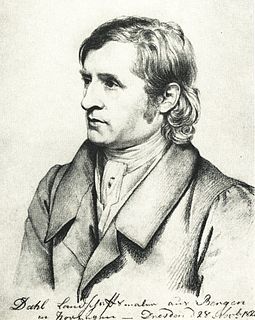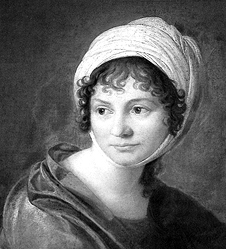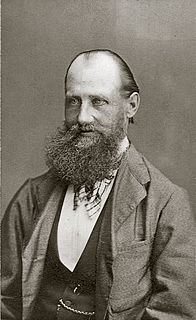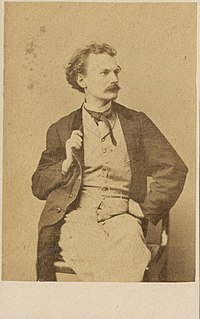
Johann Siegwald Dahl (16 August 1827, Dresden - 15 June 1902, Dresden) was a German animal painter.

Johann Siegwald Dahl (16 August 1827, Dresden - 15 June 1902, Dresden) was a German animal painter.
He was one of nine children born to the Norwegian painter, Johan Christian Dahl and his first wife Emilie. Of those, only he and one sister survived to adulthood. His first art lessons came from his father. Later, he studied animal painting with Johann Friedrich Wilhelm Wegener .
After three more years attending the Dresden Academy of Fine Arts, he paid a visit to London to study with Edwin Landseer; another famous animal painter. He also spent some time in Paris. Upon his father's death in 1857, he donated a collection of his studies and drawings to the National Gallery in Oslo and the Bergen Billedgalleri . He became an honorary member of the Gemäldegalerie Alte Meister in 1864.
His best known works involve Norwegian motifs, inspired by his father's works and numerous visits to Norway, but he also created some portraits. His works may be seen at several museums in Dresden and Hanover.
His sister Caroline was married to the Norwegian cabinet minister, Anders Sandøe Ørsted Bull.

Caspar David Friedrich was a 19th-century German Romantic landscape painter, generally considered the most important German artist of his generation. He is best known for his mid-period allegorical landscapes, which typically feature contemplative figures silhouetted against night skies, morning mists, barren trees or Gothic ruins. His primary interest was the contemplation of nature, and his often symbolic and anti-classical work seeks to convey a subjective, emotional response to the natural world. Friedrich's paintings characteristically set a human presence in diminished perspective amid expansive landscapes, reducing the figures to a scale that, according to the art historian Christopher John Murray, directs "the viewer's gaze towards their metaphysical dimension".

Anton Raphael Mengs was a German painter, active in Dresden, Rome, and Madrid, who while painting in the Rococo period of the mid-18th century became one of the precursors to Neoclassical painting, which replaced Rococo as the dominant painting style in Europe.

Anton Graff was an eminent Swiss portrait artist. Among his famous subjects were Friedrich Schiller, Christoph Willibald Gluck, Heinrich von Kleist, Frederick the Great, Friederike Sophie Seyler, Johann Gottfried Herder, Gotthold Ephraim Lessing, Moses Mendelssohn and Christian Felix Weiße. His pupils included Emma Körner, Philipp Otto Runge and Karl Ludwig Kaaz.

Johan Christian Claussen Dahl, often known as J. C. Dahl or I. C. Dahl, was a Danish-Norwegian artist who is considered the first great romantic painter in Norway, the founder of the "golden age" of Norwegian painting, and, by some, one of the greatest European artists of all time. He is often described as "the father of Norwegian landscape painting" and is regarded as the first Norwegian painter to reach a level of artistic accomplishment comparable to that attained by the greatest European artists of his day. He was also the first to acquire genuine fame and cultural renown abroad. As one critic has put it, "J.C. Dahl occupies a central position in Norwegian artistic life of the first half of the 19th century.

Christian Wilhelm Ernst Dietrich was a German painter and art administrator. In his own works, he was adept at imitating many earlier artists, but never developed a style of his own.

Johann Michael Ferdinand Heinrich Hofmann was a German painter of the late 19th to early 20th century. He was the uncle of the German painter Ludwig von Hofmann. He was born in Darmstadt and died in Dresden. He is best known for his many paintings depicting the life of Jesus Christ.

The Dresden Academy of Fine Arts, often abbreviated HfBK Dresden or simply HfBK, is a vocational university of visual arts located in Dresden, Germany. The present institution is the product of a merger between the famous Dresden Art Academy, founded in 1764, the workplace and training ground of a number of influential European artists, and another well-established local art school, Hochschule für Werkkunst Dresden, after World War II.

Christian Gottlob Hammer, baptized as Gottlieb,, was an influential German landscape painter and engraver.

DoraStock was a German artist of the 18th and 19th centuries who specialized in portraiture. She was at the center of a highly cultivated household in which a great number of artists, musicians, and writers were guests; and her friends and acquaintances included some of the most eminent figures of her day, namely Goethe, Schiller and Mozart.

Johann Christian Reinhart was a German painter and engraver. He was one of the founders, along with Joseph Anton Koch, of German romantic classical landscape painting.

For much of its history Norwegian art is usually considered as part of the wider Nordic art of Scandinavia. It has, especially since about 1100 AD, been strongly influenced by wider trends in European art. After World War II, the influence of the United States strengthened substantially. Due to generous art subsidies, contemporary Norwegian art has a high production per capita.

Ferdinand von Wright was a Finnish painter - He is best known for his landscapes and animal paintings, especially his detailed depictions of birds, but he also created still-lifes and portraits.

Thomas Fearnley was a Norwegian romantic painter, a pupil of Johan Christian Dahl and a leading representative of Norwegian romantic nationalism in painting. His son Thomas Fearnley (1841–1927) founded the Fearnley dynasty of shipping magnates.

Johann Hermann Carmiencke or John Hermann Carmiencke was a landscape painter and etcher.

Friedrich Eduard Meyerheim was a German painter.

Cairn in Snow, also known as Dolmen in the snow, is a landscape painting by the German painter Caspar David Friedrich. Friedrich is noted for his landscapes depicting features such as trees or Gothic ruins, silhouetted against the sky or in morning mists. The painting depicts leafless trees in the winter snow, with the tops of two of the trees broken off and the third bent by the prevailing wind, giving the work a haunted, spectral air. It is a Romantic allegorical landscape, depicting a stone cairn or dolmen set amid three oak trees on a hilltop, with a contemplative melancholy mood. It was probably painted around 1807, making it among Friedrich's first oil paintings. It measures 61 by 80 centimetres and has been held by the Galerie Neue Meister in Dresden since 1905.

Ernst Ferdinand Oehme was a German Romantic painter and illustrator who specialized in moody landscapes with architectural elements.

Karl Heinrich Hoff was a German genre painter, best known for his 18th century period scenes. He is generally referred to as The Elder, to distinguish him from his son, Karl Heinrich, who was also a painter.

Heinrich Stuhlmann was a German painter, graphic artist and amateur photographer.

Christian Richter (1678–1732) was a Swedish miniature-painter and copyist, active mainly in England.